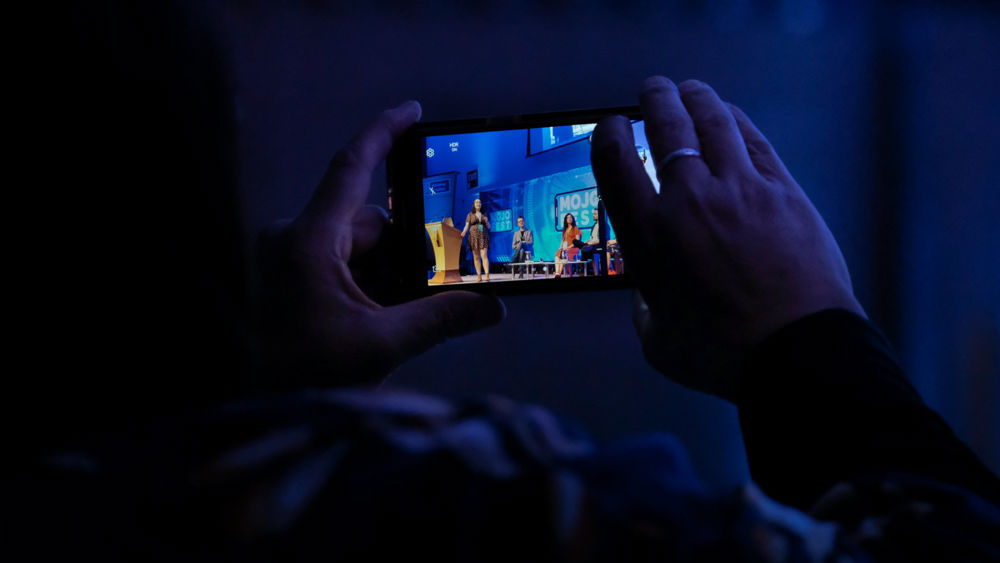Award-winning mobile journalist Leonor Suárez’s original stories shot on her smartphone imitated those she produced in a more traditional way with a video camera.
Two years of exploration with this emerging form of new media storytelling and Leonor has moved from a fascination in techniques, gadgets and new gear to investigating how “mojo” can be used to tell stories in different and challenging ways.
“I have been testing new stories, exploring news ways of storytelling, exploring new formats, new platforms,” says Leonor. “I am now exploring all the time.”
Spanish journalist Leonor who won Thomson Foundation’s Mobile Journalism Competition in 2016 was talking to the 2018 winner Gisella Rojas Rodriguez at Mojofest, a conference about mobile journalism held in Galway, Ireland.
Storytelling
Award-winning mobile journalists Leonor Suárez and Gisella Rojas Rodriguez discuss the benefits of smartphone journalism.
When mobile journalism wins
Leonor started using her smart phone for storytelling because it enabled her to tell stories in a more personal way. Her winning entry highlighted the harsh working conditions in a Bolivian silver mine.
Gisella, a journalist from Ecuador who is currently studying in Mexico, chose to use her mobile phone to film people travelling on the migrant bus to the border with the United States of America because people weren’t intimidated by it.
“I had my DSLR camera with me and every time I took my camera out they waved me away,” she said. “So I would talk to people for an hour and then I said to them can I interview you on my smartphone? The phone is not intimidating.”
Gisella Rojas Rodriguez, 2018 winner of Mobile Journalism Competition
Mojofest
Mojofest 2018 attracted mobile journalists and enthusiasts from all over the world to the National University of Ireland Galway’s campus on the west coast of Ireland. It is to this community of “mojos” that Leonor turns to for support.
“When you’re back home you’re working alone most of the time, most of your colleagues are not “mojos”, so they do not understand your needs,” she told Gisella. “They do not understand when you are talking about changing the storytelling. So whenever we get together it’s an opportunity for us to work ahead, to improve, to share, to be energetic, to keep going for another year.”

Sir Cam @camdiary
iOS v Android
Mobile journalism is an evolving field with new apps and equipment being developed and coming on to the market all the time.
Initially iOS was the favoured system because of the higher-quality apps and a larger developer base.
The android system with hundreds of different versions running on thousands of different devices makes it much more difficult for developers to work with.
However the majority of the world’s smartphone users have android phones and so the needs of “android mojos” are gradually being catered for.

Sir Cam @camdiary
Mojo advice
For Leonor, mobile journalism is now less about the latest kit and more about how to exploit this emerging technology for storytelling.
Her advice to those new to the form is to “keep it simple”.
“Every day you buy new gear, you try new gadgets but at the end of the day most of the time you end up using the same gear,” she says. ”A grip, a good professional microphone is key and a light is enough to produce a good story. The most important part is the story and to have an idea of how to tell the story.”
Gisella was at Mojofest in Ireland as part of her prize for winning the Thomson Foundation Mobile Journalism Competition.
She plans to use the second part, a mojo kit including an iPhone, to film her stories but also to train others in South America where mobile journalism is in its infancy.
Gisella Rojas Rodriguez
The migrant bus 2018 – in search of a safer life in the USA
Leonor Suárez
Inside Potosi silver mines – the harsh working conditions